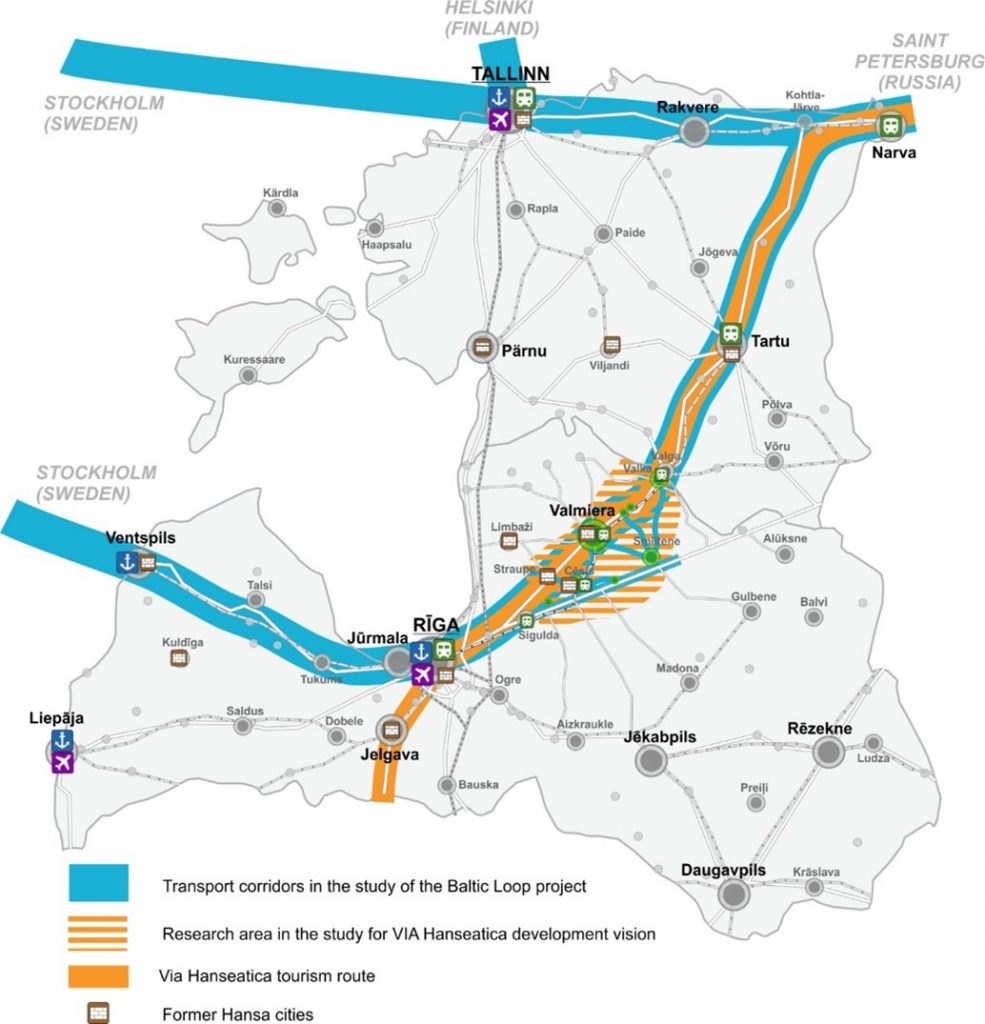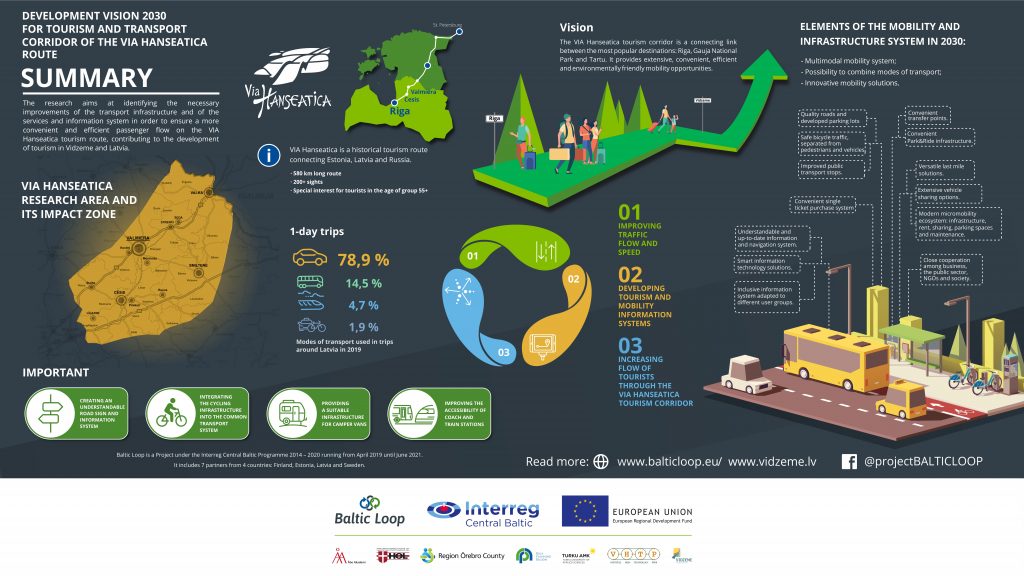VIA Hanseatica is a historically ancient tourism route connecting Russia, Estonia and Latvia. This route is based on historic transport and trade routes from St. Petersburg through Tartu to Riga and further to Western Europe.
VIA Hanseatica and its adjacent area serve as an important tourism development corridor, however, one of the limiting factors for achieving its full potential is the availability and quality of transport services. Both local and foreign tourists, looking for an alternative means of transport for personal road transport, face the fragmentation of the proposed transport solutions, the lack of digitally available information, as well as the inconvenience of public transport use and the incompatibility of scheduling times, which hampers convenient movement between several tourism sites in the vicinity of the transport corridor. Also when choosing personal road transport, tourists face different barriers, such as the quality of infrastructure (road condition, lack of road signs).

On the tourism route VIA Hanseatica, the transport flow in the Vidzeme planning region is moving along the country’s main road A3 Incukalns – Valmiera – Estonian border (Valka), the railway line Riga – Lugaji – the state border, as well as the functionally linked section of the road A2 Incukalns – Drabesi and section of the road P20 Drabesi – Cesis – Valmiera, including the direction of Smiltene – Valka.
The vision of VIA Hanseatica for 2030 highlights its connecting function and its mobility: VIA Hanseatica tourism corridor is the connecting wire between the most demanding destinations – Riga, Gauja National Park and Tartu, which provides extensive, convenient, efficient and environmentally friendly mobility opportunities.

Accessibility of mobility services and infrastructure is one of the main prerequisites for the development of the tourism route VIA Hanseatica. The overall traffic flow will be made more efficient by improving transport infrastructure, public transport services, connections, enabling different modes of transport to be used for the first/last kilometre and introducing new mobility opportunities in the area of the influence of the VIA Hanseatica.
The travel time spent by passengers, including tourists, will be reduced not only by full-fledged infrastructure of the main national roads A2 and A3, but also by the regional and local roads of the state in good technical condition in the VIA Hanseatica impact area, as well as by municipal roads to important tourism sites such as the Ligatne nature trails, Zvartes Rock, Ergļu (Eagle) Cliffs etc.
Vidzeme is crossed by several internationally recognised cycling and pedestrian routes, an important resource for the development of cycling and pedestrian tourism. The perspective for the development of cycling tourism is highlighted not only by the development of infrastructure but also by the increase in the number of users. No less important is the availability of bicycles – rental facilities, availability of electric bikes, sheds, maintenance points, etc. Safe cycling infrastructure will not only boost the choice of locals but also tourists in favour of cycling, reducing the negative impacts of cars on climate change and environment.
The key to public transport is its availability, both in terms of routes and number of journeys, and modern and environmentally friendly passenger services. Convenient connections between different types of public transport and routes will also improve passenger traffic by strengthening the role of public transport and will allow to reduce travel time. Intermodal connection points will be developed in Cesis, Valmiera and Valka, connection points – Smiltene and Berzkrogs.
The popularity of public transport among tourists will also be increased by impact of the infrastructure of park & ride established at multimodality points. Sites of micromobility services where the preferred means of transport may be leased for a short distance will be located in Ligatne, Augsligatne, Cesis, Rauna, Liepa, Smiltene, Strenci and Stalbe, as well as at the beginning/end points of the major cycling routes. In electronic environment, continuous development of information will be available on possible route changes, recreational areas, conditions of movement, etc. factors affecting traffic flows. A major step in the development will be a single ticketing system. Information infrastructure such as road signs, a common and broad labelling system and institutional cooperation to promote the development of tourism and mobility are also important.
Access to the VIA Hanseatica tourism route for tourists needs to be improved in order to meet the set vision and meet the objectives. The integration of the international rail line Rail Baltica, the planned implementation of the common traffic reorganisation and the first level connections should be taken into account. Cross-border bus and train routes should also be improved. The infrastructure of the railway line Riga-Lugaji-Valka and the passenger trains will be up-to-date, accessible to people with reduced mobility, easy boarding/ disembarkation and day-to-day transportation of bicycles. Infrastructure should be developed to improve mobility for pedestrians, cyclists and other micro-mobility options, making it as safe and convenient as possible.
In the impact area of the tourism route VIA Hanseatica there are more than 200 different viewing sites, series of leisure activities and sporting venues, catering companies that present cultural and culinary heritage of Vidzeme. Tourism facilities are most densely located from Ligatne to Cesis, around Valmiera, Rauna and Smiltene, which indicate the main tourist attraction areas.
Smiltene and Valka/Valga and neighbouring areas are marked as tourism key areas. Given the context of VIA Hanseatica as a historic trading route for Hanza, it is necessary to particularly highlight the existing cities and towns of Hanza – Valmiera, Cesis and Straupe, which have rich cultural and historical heritage. Also in perspective, this area will be a key to attracting tourists, increasing the flow of tourists to the surrounding areas. The variable terrain of The Gauja Valley and Vidzeme Heights is a great advantage in providing both landscape views and offers of active winter recreation, reducing the seasonality of tourism.
In 2020, tourist habits have changed significantly under the influence of the Covid-19 pandemic. Natural trails and nature sites are more frequently visited. As the situation changes, the habit of visiting nature sites on a regular basis is expected to persist. The number of visitors to such sites after five years could be three times higher than in 2019.
The VIA Hanseatica tourism route is on the way for those who are going to pass Vidzeme further to Estonia (Tartu) and constitute a strong alternative to the VIA Baltica route. This implies the need to improve road A2 and A3 amenities, starting with the quality of road surface coverage, the improvement of services and recreational points.
Cesis, Valmiera, Ligatne, Valka and Smiltene are the main tourist attraction cities and towns on the VIA Hanseatica tourist route, where multimodal connections, micromobility and services are to be developed. Sigulda is an important tourism anchor town on the VIA Hanseatica route in the Riga Planning Region, with which cooperation in promoting tourism flows shall be developed.
Strengthening of the macro-regional role of the VIA Hanseatica tourism route in Vidzeme is marked by the development and promotion of its brand, the development and diversification of tourism services, and the development of cooperation between stakeholders at different levels. The VIA Hanseatica route is viable and will develop successfully in the future due to the active involvement and cooperation of all stakeholders – tourism entrepreneurs, municipalities, tourism organisations, managers of territories, universities, local society. This will be a modern and passenger-friendly tourism corridor, which will ensure fast, convenient and safe movement.
Full text in Latvian is available Here: Part I – Current situation and Part II – Strategic part

>> Click on the picture to enlarge it


